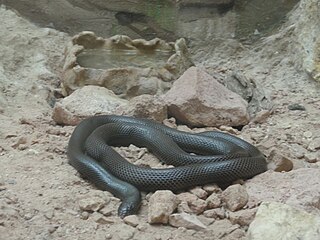
Walter Hood Fitch was a botanical illustrator, born in Glasgow, Scotland, who executed some 10,000 drawings for various publications. His work in colour lithograph, including 2700 illustrations for Curtis's Botanical Magazine, produced up to 200 plates per year.
August Gustav Heinrich von Bongard was a German botanist who worked in Saint Petersburg, Russia.

Atractaspis is a genus of venomous snakes in the family Atractaspidae, also known as the stiletto snakes. The genus is endemic to Africa and the Middle East. The genus contains 15 species that are recognized by ITIS. Others recognize as many as 21 species. 23 are listed here.

The Indian tent turtle is a species of turtle in the family Geoemydidae. The species is found in India, Nepal, and Bangladesh.

Leptoceroidea is a superfamily of caddisflies.

Carlton Brandaga Curtis was an American politician from Pennsylvania who served as a Democratic member of the U.S. House of Representatives for Pennsylvania's 23rd congressional district from 1851 to 1853 and the 24th district from 1853 to 1855. He then switched parties and later served again as a Republican member for the 19th district from 1873 to 1875.

The Psychomyiidae are a family of tube-making caddisflies. Members of this family are typically very similar to polycentropodids, most of them can be differentiated by the spur formula is 2-4-4, thyridial cell short, absence of the forewing fork I, and hindwing forks I and IV. Male genitalia has elongate preanal appendages, and reduced tergum IX. The larvae differ by the submental sclerites separated, foretrochantin broad, and the pupal mandible apex whip-like. Larvae construct long silken galleries.

Nemaxera is a genus of the fungus moth family, Tineidae. Therein, it belongs to the subfamily Nemapogoninae. The genus is considered monotypic, with the single species Nemaxera betulinella placed here.

The Harpactorinae are a large subfamily of the Reduviidae. About 300 genera and 2,000 species worldwide have been described. Some of the species of the genera Zelus, Pselliopus, Sinea, and Apiomerus are of interest as biological pest control agents.

Brachycentridae is a family of humpless casemaker caddisflies in the order Trichoptera. It is found in North America, Europe, and Asia. Georg Ulmer first described it in Germany in 1903 as a subfamily of Sericostomatidae. The type genus for Brachycentridae is Brachycentrus J. Curtis, 1834.

Molannidae is a family of Hood casemakers in the order Trichoptera. There are at least 3 genera and 40 described species in Molannidae.

Brachycentrus is a genus of humpless casemaker caddisflies in the family Brachycentridae. There are at least 30 described species in Brachycentrus.

Anabolia is a genus of northern caddisflies in the family Limnephilidae. There are about 18 described species in Anabolia.

Agraylea is a genus of microcaddisflies in the family Hydroptilidae. There are more than 20 described species in Agraylea.
Philopotamus is a genus of insects in the family Philopotamidae.

Beraea is a genus of insects in the family Beraeidae.
Coniopteryx is a genus of insects belonging to the family Coniopterygidae.

Trichostegia is a genus of insects belonging to the family Phryganeidae.

Potamophylax is a genus of insects belonging to the family Limnephilidae. The species of this genus are found in Europe and Northern America.















